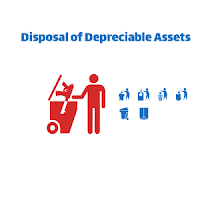Disposal of Depreciable Assets
A Non Current Asset / Fixed Asset may be disposed off at any time time during its Useful Life. When Assets disposed off, The disposal of Fixed Assets results in Gains, Loss and No
Gains No Loss for the business. If the Book Value is more than the Cash Received, there is Gains / Profit On Sale of Assets. But, If Books Value is lesser than the amount of Cash Received, then Loss is the result on the sale
of Fixed Assets. Sometimes, the Book Value is Equal to the amount of Cash Received, then Entrepreneur neither gains nor losses but, in fact, the Entrepreneur is at the Break Even Point on the Sale of Fixed Assets.
The Entrepreneur may also sale the Fixed Assets in the market or exchange with new Fixed Assets in the market. This is called Exchanging or Traded In of Assets or Sale of Old Assets And Buying New Assets of the Same Nature, i.e., Selling Old Machinery and Buying New Machinery, etc.
(i). Disposal At Gains
Let us consider the case of gains. Suppose, Furniture Costing Rs. 50000 having Accumulated Depreciation Rs. 45000 and Book Value Rs. 5000 (50000 - 45000). The Entrepreneur sold Furniture
in the Market For Rs. 8000. The whole process of Disposal of Furniture can be recorded in the Book / Journal of Entrepreneur in the form of Accounting Journal Entry as follows:
Accumulated Depreciation - Furniture a/c 45000
Cash a/c 8000
Furniture a/c 50000
Gains on Disposal of Furniture a/c 3000
(Gains on Sale of Furniture Recorded)
The Furniture is recorded on Credit side as Furniture has debit balance. So, in order to write off furniture, we credit it by Rs. 50000. Similarly, Accumulated Depreciation is a Contra Asset which has a reverse side (Credit Balance) with respect to Furniture. So, we Debit Accumulated Depreciation by Rs. 45000. Cash is receiving by the Entrepreneur of Rs. 8000, so we debit it. The Difference of Debit And Credit Sides gives us Gains on Disposal of Furniture which always has Normal Balance in Credit Side.
(ii). Disposal At Loss
Now, by considering the above Example, Let Say, the Furniture Sold For Rs. 3000 in the Market, then there is a Loss on Sale of Furniture and following Accounting Journal Entry is passed in the
Book or Journal of Entrepreneur:
Accumulated Depreciation - Furniture a/c 45000
Cash a/c 3000
Loss on Disposal of Furniture a/c 2000
Furniture a/c 50000
(Loss on Sale of Furniture Recorded)
In The Above Accounting Journal Entry, the Entrepreneur faced a loss of Rs. 2000 on the Disposal of Furniture.
(iii). Disposal At No Gains No Loss
In this situation, if the company sold Furniture For Rs. 5000, then there is neither Gains nor Loss as shown below:
Accumulated Depreciation - Furniture a/c 45000
Cash a/c 5000
Furniture a/c 50000
(Disposal of Furniture At No Gain No Loss Recorded)
2. When Fixed Assets Exchanged Or Traded In For New Assets
The Entrepreneur exchanged the Old Office Equipment and purchase another Office Equipment. It is called traded in for Disposal of Fixed Assets. There is Gain or Loss in Case of Exchange.
For Example, if the Machinery Costing Rs. 80000, having Accumulated Depreciation Rs. 75000. The Entrepreneur Exchanged the Old machinery with the new one by paying Cash Payment of Rs. 50000. Now, following Accounting Journal
Entry is passed in the book of Entrepreneur for this type of trade in:
Machinery (New) a/c 50000
Accumulated Depreciation - Old Machinery a/c 75000
Loss On Disposal of Machinery a/ 5000
Machinery (Old) a/c 80000
Cash a/c 50000
If the Trading Company Gives Allowance That is Trade Allowance 10% of Cost i.e., Rs 5000, then the Entrepreneur will get Gains on Disposal of Machinery.
So, Disposable of Depreciable Assets helps the Entrepreneur in updating its Non Current / Fixed Assets to meet its Business Requirements from time to time.

Comments